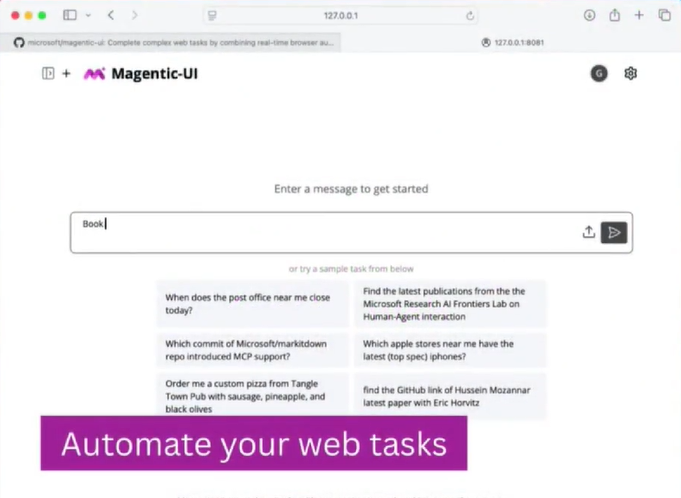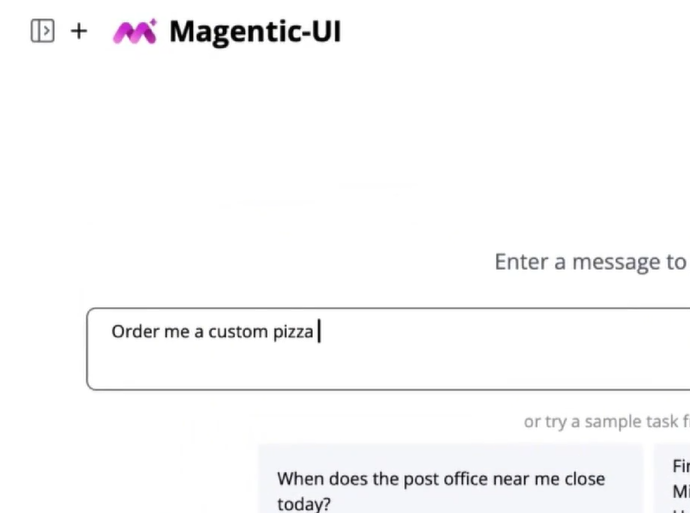At the Microsoft Build Developer Conference, Microsoft officially launched its open-source project Magentic-UI, a human-centered artificial intelligence web agent system. This innovative tool aims to intelligently automate complex web tasks while ensuring that users maintain full control over the operation process. AIbase provides an in-depth analysis of the core highlights and potential impact of this groundbreaking technology.

Magentic-UI: Intelligent Web Assistant with Human-Machine Collaboration
Magentic-UI is an open-source prototype developed by Microsoft based on its Magentic-One and AutoGen frameworks, designed to address the lack of transparency and user control in traditional AI agents for web task automation. The system, through multi-agent collaboration, can automatically complete complex tasks such as web browsing, clicking, form filling, file reading, and code generation, while maintaining high transparency. All operation steps are clearly displayed in the user interface.
Different from traditional fully automated AI agents, Magentic-UI emphasizes a "human-centered" design philosophy. After users input their task objectives, the system generates detailed execution plans (such as to-do lists), which users can modify, delete, reorder, pause, or restart at any time. This collaborative model ensures a perfect balance between automation efficiency and user control.

Transparency and Security: Users Always Hold the Initiative
The unique aspect of Magentic-UI lies in its emphasis on user trust and security. The system features a visual task panel that displays each operation step in real time, such as clicking buttons, opening pages, or sending messages. Any operations that may have irreversible consequences (such as online orders or adding items to the shopping cart) require explicit user authorization. Users can also set whitelists to restrict agent access to specific websites, further enhancing security.
In addition, Magentic-UI supports the "plan learning" function. The system can record task execution steps and save them as templates for reuse in subsequent similar tasks, thereby continuously optimizing efficiency with usage. Microsoft validated the performance of Magentic-UI on the GAIA benchmark test, showing that it autonomously completed 30.3% of 162 complex tasks, demonstrating its strong multi-modal understanding and execution capabilities.
Multi-Agent Architecture: FireSurfer and Docker Empowerment
Magentic-UI is based on Microsoft's self-developed Magentic-One framework, adopting a multi-agent collaborative working mode, including the FireSurfer agent, responsible for handling complex operations such as file conversion and code execution. The system runs in a Docker container environment, ensuring operational safety and stability through isolation mechanisms. This modular design not only enhances system flexibility but also provides rich possibilities for developers.
For example, when users input "help me check flights," Magentic-UI will automatically generate a task plan: open the flight inquiry website, search for flights within the specified time period, and record prices. Users can further adjust the plan, such as adding a filter condition like "only show direct flights," and the system will execute according to the modified instructions precisely.
Open Source Ecology: Empowering Developers and the Community
As a completely open-source project, Magentic-UI has been released on GitHub under a permissive MIT license, attracting significant attention from developers and researchers. Within a short time after release, the project garnered hundreds of stars, reflecting the community's high recognition. Microsoft hopes to invite global developers to jointly optimize this human-machine collaborative intelligent agent system through open source, accelerating the construction of the "open agent network" (Agentic Web).
Microsoft Chief Technology Officer Kevin Scott stated that Magentic-UI is an important step towards the "agent network." In the future, AI agents will be able to collaborate seamlessly across platforms, automating more complex tasks.
Application Prospects: From Personal Efficiency to Enterprise Transformation
Magentic-UI has a wide range of application scenarios, covering personal productivity enhancement and enterprise process optimization. Individual users can use it to complete daily tasks, such as automating form filling or data collection; enterprises can integrate it into complex workflows, such as automating customer service or data analysis. Microsoft also plans to further expand the functionality of Magentic-UI through Azure AI Foundry and Copilot Studio, helping enterprises build customized intelligent agents.
AIBase believes that the launch of Magentic-UI marks the transition of AI agent technology from full automation to human-machine collaboration. With its transparency, security, and open-source characteristics, this tool not only provides users with efficient web task solutions but also opens up new innovation spaces for developer communities.
Conclusion: Intelligent Assistant to Control the Future
With its unique human-machine collaboration model and powerful automation capabilities, Magentic-UI brings a new experience to web task processing. Whether simplifying personal work or driving enterprise digital transformation, this open-source tool shows infinite possibilities. AIBase will continue to follow the subsequent iterations and application progress of Magentic-UI, bringing you more cutting-edge tech news.
